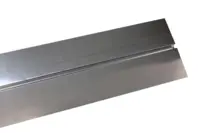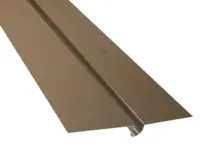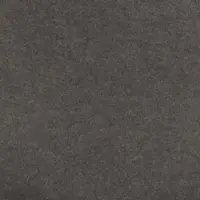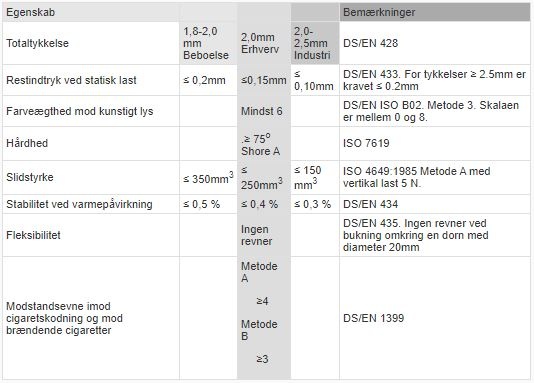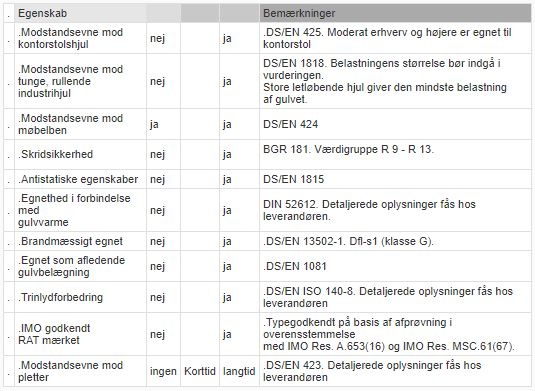- Akustikpaneler
- Afpassede tæpper
- Bambusgulve
- Bordplader & bordben
- Designgulve
- Fliser og klinker
- BeefEater gasgrill
- Gode råd om gulv
- Gulvtæpper
- Gulvvarme
- Græstæpper
- Korkgulve
- Køkken, bad & garderobe
- Laminatgulve
- Linoleumsgulve
- Maling, Væv & Spartel
- Måtter
- Møbler & Boliginteriør
- Nålefilt og messetæpper
- Plejeprodukter
- Restpartier & gode tilbud
- Sildebensparket & Stavparket
- Tæppefliser
- Terrassebrædder
- Tilbehør
- Trægulve
- Vareprøver
- Vinylgulv
- Værktøj
- Øvrige produkter
- Loft- og vægpaneler
- Flotte gulve
- Fyrretræsgulv
- Klikgulve
- Bestilte varer
-
-26%
-
Populær29,00 DKK
-
29,00 DKK pr m2
-
Populær21,00 DKK
-
-59%39,00 DKK pr m295,00 DKKDu sparer: 56,00 DKK pr m2
Gummi
Alle informationer på denne side er kopieret materiale fra Gulvfakta som er et fagteknisk opslagsmateriale, Kilde: Gulvfakta
Gummigulve fremstilles af naturligt eller syntetisk gummi eller en blanding af de to typer. For at forbedre egenskaberne iblandes stabilisatorer, fyldstoffer, pigmenter og vulkaniseringsmidler. Gummifliser fremstilles ved støbning eller kalandrering. Gummibelægning til gulve er utroligt slidstærkt og er derfor en meget praktisk belægning til dit gulv. Læs mere i dette indlæg om gummibelægning til dit gulv, hvor vi berører nedenstående, som fremgår af indholdsfortegnelsen.
1.3.4.1 Introduktion
1.3.4.2 Egenskaber
1.3.4.3 Krav til udførelsesstedet
1.3.4.4 Lægning og brug
1.3.4.5 Rengøring
1.3.4.6 Checkliste
Alle informationer på denne side er kopieret materiale fra Gulvfakta som er et fagteknisk opslagsmateriale, Kilde: Gulvfakta
1.3.4.1 Introduktion
• Gummigulve anvendes i skoler, sygehuse, kontorer, butikker, indgangspartier mv., især anvendes gummigulve, hvor der forventes stærkt slid. Endvidere findes der formstøbte trappetrin i gummi.
• Gummi leveres både som banevarer og fliser i tykkelser mellem 2 og 12 mm. Tykkelsen vælges afhængigt af gulvets anvendelse/brugsintensitet. Der leveres banebredder og fliser i flere forskellige størrelser.
• Gummi, der anvendes som gulvbelægning, skal være CE mærket.
• Gummi der benyttes som gulvbelægning i flugtveje og andre områder med krav til brand og røgudvikling, skal have dokumentation for at opfylde den europæiske brandklasse Dfl-s1 i henhold til DS/EN 13501-1 (klasse G gulvbelægning).
• Gummi kan leveres med profileret overflade for at forbedre gangsikkerheden og som elektrostatisk afledende gulvbelægning til anvendelse i rum med krav til personafladning. Leverandøren kan give detaljerede oplysninger om belægningerne elektriske modstandsevne.
• Gangkomforten og trinlyddæmpningen for gummigulve vil sædvanligvis være god.
• Overfladen af gummigulve er glat og nem at renholde. Gummigulve kan normalt kun modstå kortere tids påvirkning af olie og fedt (især animalsk fedt). Der må derfor foreskrives specialprodukter, hvis der er behov for, at gulvet skal kunne klare længere tids påvirkning af disse stoffer.
• Gummigulve kan blive misfarvet af kraftig solstråling, fx i glasbygninger, og bør derfor kun anvendes sådanne steder efter accept fra leverandøren. Der findes specielle UV-bestandige gummibelægninger.
1.3.4.2 Egenskaber
Gummigulve, som er EN-klassificeret, skal opfylde kravene i DS/EN 1817 og skal dermed overholde specifikke krav til:
• Længde, bredde, rethed og fladevægt
• Dimensionsstabilitet ved varmepåvirkning
• Tykkelse, fleksibilitet og modstandsevne mod indtrykningsmærker
• Slidstyrke
• Farveægthed mod kunstigt lys.
Klassificering af gummi sker efter anvendelsesområde med tykkelsen som grundlag for klassificeringen, se checkliste 13. Der er for alle klasser et krav om en minimumstykkelse af slidlaget på 1 mm. For klasse "Erhverv Moderat" og højere er belægningerne egnet til brug med kontorstolshjul. De i checkliste 13 viste klasser beboelse, erhverv og industri kan yderligere opdeles i moderat, normal, høj og meget høj. Udover de egenskaber, der indgår i klassificeringen, vil der ofte være behov for at stille krav til andre egenskaber, afhængigt af den aktuelle anvendelse, fx på grund af specielle påvirkninger eller ønsker fra slutbrugeren.
Disse egenskaber indgår i Gulvbranchens supplerende egenskaber, som for gummigulve omfatter:
1.3.4.3 Krav til udførelsesstedet
Der skal være afsat tid til, at gummibelægningen kan akklimatiseres. Akklimatiseringen sker ved, at banerne opskæres og lægges løst ud over gulvet, mens fliser anbringes i uåbnet emballage i rummet, hvor de skal lægges. Akklimatiseringen skal vare i mindst 24 timer. For belægninger over 2,5 mm skal akklimatisering ske ved, at belægningen udlægges løst over gulvet. Under og efter limning af gummigulve skal temperaturen i luften og undergulvet være 17 - 25°C og luftfugtigheden mellem 35 og 75% RF. Underlaget skal have samme planhed, som kræves af det færdige gulv, normalt ± 2 mm. på et 2 m. retholt. Planhed og gulve, herunder krav og målemetoder, er beskrevet i sektionen Teknik og kvalitet
Skal gummigulve udlægges direkte på støbte dæk, må betonens porefugt (restbyggefugt) højst være 85% RF. Fugt og gulve, herunder krav og målemetoder, er beskrevet i sektionen Teknik og kvalitet. Der må ikke være kraftig træk eller kraftigt solindfald under lægningen af gulvet. Gummibelægninger skal lægges på et sugende underlag for at sikre, at limen hæfter godt til underlaget. Såfremt der ikke er tilstrækkelig sugeevne, fx på underlag af asfalt eller epoxy, skal der påføres et mindst 2 mm tykt, lag af en spartelmasse, som af spartelmasseleverandøren foreskrives til det aktuelle underlag. I situationer, hvor der ikke kan påføres et lag spartelmasse som sugende underlag, kontaktes belægningsleverandøren for anvisning af limmetode.
1.3.4.4 Lægning og brug
Forhold i forbindelse med lægning og brug
Korrekt friskæring i banesamlinger er vigtig, da limfugen i første del af limens hærdefase ikke vil kunne fastholde belægningen til underlaget, hvis der sker sammenpresning i samlingen. Leverandørens anvisninger om udførelse af til og sammenskæringer skal følges. Gummigulve lægges normalt med stødte samlinger, men fugerne kan også forsegles med fugemasse eller en speciel fugetråd. På grund af gummiens overfladeegenskaber bør belægningsleverandørens anvisninger om limning følges nøje. Hvor der forventes store mekaniske belastninger eller store fugt- og/eller temperaturvariationer, bør der anvendes en 2-komponent polyuretan-klæber (PU-klæber). Monteringstiden afhænger af de materialer, der skal klæbes sammen og af fugt- og temperaturforholdene i rummet.
Elektrostatiske afledende gulve
Gummi er egnet som afledende gulvbelægning og kan anvendes i lokaler hvor der er behov for bortledning af elektriske opladninger. Afledende gummibelægninger har en speciel sammensætning og lægges i ledende lim. Desuden skal gulvet yderligere være forbundet til jord gennem kobbertråd i henhold til leverandørens anvisninger. Det skal aftales, hvor gulventreprenøren skal føre kobbertråden op ad væggen. Udførelse af elektrostatisk afledende gummigulve bør foretages i samråd med belægningsleverandøren. Jording skal foretages af autoriseret el-installatør. Statisk afledende og statisk ledende elastiske gulvbelægninger - begreber, krav m.m.
1.3.4.5 Rengøring
Inden ibrugtagning skal der altid foretages en grundrengøring for at fjerne rester af slipmiddel fra belægningens overflade. De fremtidige brugere skal oplyses om korrekt rengøring, da forkert rengøring kan medføre skader på overfladen. Leverandørens anvisning om rengøring og vedligeholdelse af gummigulve skal udleveres til brugeren. Til daglig rengøring anvendes fortrinsvis tørre metoder dvs. tør- eller fugtmopning eller støvsugning. Til kraftigere, lejlighedsvis rengøring anvendes milde rengøringsmidler uden stærkt alkaliske stoffer som anvist af belægningsleverandøren. Rengøring af gummigulve er omtalt i sektionen Rengøring.
1.3.4.6 Checkliste 13 og 14
Checkliste 13. Egenskaber, som indgår i EN-klassifikationen for gummigulve. Klassifikationen sker på grundlag af tykkelsen. Øvrige egenskaber overholder for klassificerede produkter de markerede værdier.
Checkliste 14. Supplerende egenskaber, som der kan være behov for at stille krav til, fx på grund af særlige påvirkninger af gulvet ved den aktuelle brug.

